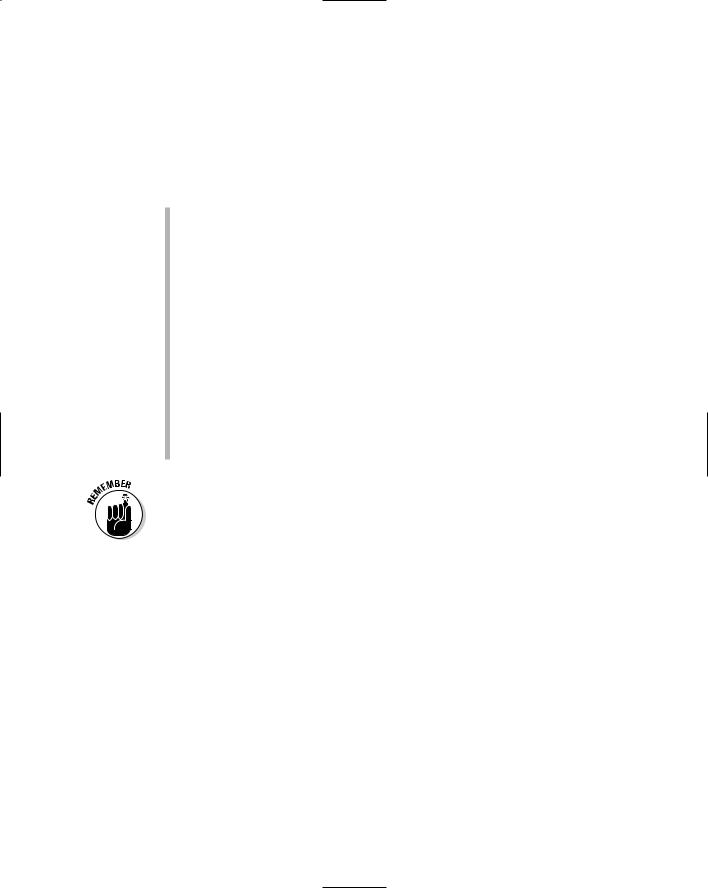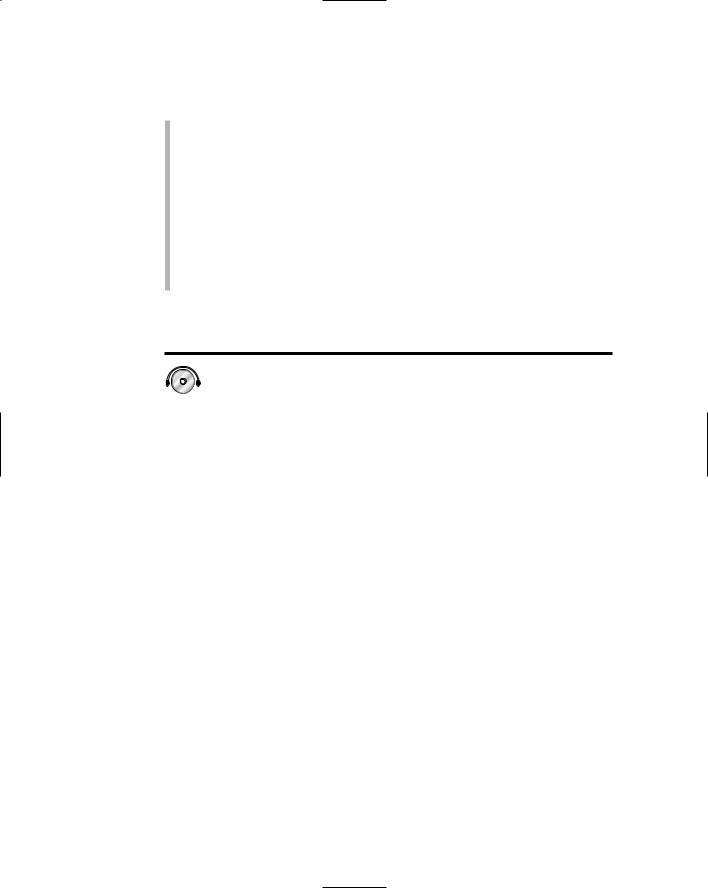
Arabic_for_Dummies
.pdf
206 Part III: Arabic on the Go ____________________________________________
Be sure to define the subject following ‘ayna. As I explain in Chapter 3, you define a subject by adding the definite article prefix al- to the subject noun. For example, funduq means “hotel,” and al-funduq means “the hotel.” So if you’re asking where the hotel is located, you say, ‘ayna al-funduq? (Where is the hotel?) and not ‘ayna funduq?, which translates to “Where is hotel?”
“Where” questions are useful for more than just asking for directions. You may also apply the ‘ayna question format to human subjects, such as friends or family. For instance:
‘ayna maryam? (eh-yeh-nah mee-ree-yam; Where is Myriam?)
‘ayna al-‘aTfaal? (eh-yeh-nah al-aht-faal; Where are the children?)
‘ayna ‘ummii? (eh-yeh-nah ooh-meey; Where is my mom?)
You don’t need to use the definite article al- when referring to a noun that’s already defined. For instance, in one of the preceding examples, maryam doesn’t require the definite article prefix al- because she’s a specific person. So make sure that you don’t go around adding the prefix al- to every subject after ‘ayna because sometimes there’s no question about what subject you’re referring to.
Answering “where” questions
Asking a “where” question is fairly straightforward (see the preceding section), but answering ‘ayna questions isn’t always as clear-cut. You can answer an ‘ayna question in a number of different ways, ranging from
the simple to the convoluted. In order to answer ‘ayna questions, you have to understand the structure of the ‘ayna question reply, which usually follows this format: subject, preposition, object.
Take a look at some common ‘ayna questions and their corresponding replies:
‘ayna al-mustashfaa? (eh-yeh-nah al-moos-tash-faah; Where is the hospital?)
al-mustashfaa fii al-madiina. (al-moos-tash-faah fee al-mah-dee-nah; The hospital is in the city.)
‘ayna al-maT’am? (eh-yeh-nah al-mah-tam; Where is the restaurant?)
al-maT’am qariib min al-funduq. (al-mah-tam kah-reeb meen al-foon-dook;
The restaurant is close to the hotel.)
‘ayna al-kitaab? (eh-yeh-nah al-kee-taab; Where is the book?)
a-kitaab taHta aT-Taawila. (al-kee-taab tah-tah at-tah-wee-lah; The book is underneath the table.)

______________________________________ Chapter 12: Asking for Directions 207
Notice that in these examples, you use a preposition to establish a connection between the subject (in this case, what or who you’re looking for) and the object (the location of the desired subject). In order to establish the desired relationship, it’s very important for you to be familiar with some common prepositions:
‘alaa (ah-laah; on)
fii (fee; in)
‘ilaa (ee-laah; to)
qariib min (kah-reeb meen; close to)
ba’id min (bah-eed meen; far from)
bijaanib (bee-jaah-neeb; next to)
fawqa (faw-kah; on top of)
taHta (tah-tah; underneath/below)
‘amaama (ah-maah-mah; in front of)
waraa’a (wah-raah-ah; behind)
yamiin min (yah-meen meen; right of)
yasiir min (yah-seer meen; left of)
Recall that the subject in the ‘ayna interrogatory sentence must be defined (see “Asking ‘where’ questions” earlier in the chapter for details); similarly, the subject in the reply to an ‘ayna question must also be defined. In addition, the object in the ‘ayna reply statement should be defined as well, either by using the definite article prefix al- or by including a predefined object.
Getting Direction About Directions
Understanding the format of the ‘ayna question and reply structures is an important first step toward approaching native Arabic speakers and asking them for directions.
Asking for directions
Of course, you can’t just go up to someone and ask them bluntly, ‘ayna al-funduq? (Where is the hotel?). That wouldn’t be very polite. The proper etiquette for approaching someone and asking for directions is to first say

208 Part III: Arabic on the Go ____________________________________________
as-salaamu ‘alaykum (ah-sah-lah-moo ah-lay-koom; hello) or ‘ahlan wa sahlan
(ah-hel-an wah sah-hel-an; hi) and then ask if he or she would permit you to ask a question. For example, you begin the exchange by saying, ‘afwan. hal yumkin ‘an ‘as’alaka su’aalan? (ahf-wan. hal yoom-keen an ass-ah-lah-kah soo-aah-lan; Excuse me. May I ask you a question?).
After the person agrees to take your question, you may proceed to ask for directions. (For more information on greetings and introductions, see Chapter 3.)
Talkin’ the Talk
While visiting Casablanca, John is trying to find the museum. He stops Ahmed, a passerby, and asks him for directions.
John: |
‘as-salaamu ‘alaykum. |
|
ah-sah-lah-moo ah-lay-koom. |
|
Hello. |
Ahmed: |
wa ‘alaykum ‘as-salaam. |
|
wah ah-lay-koom ah-sah-laam. |
|
Hello. |
John: |
‘afwan. hal yumkin ‘an ‘as’alaka su’aalan? |
|
ahf-wan. hal yoom-keen ann ass-ah-lah-kah |
|
soo-aah-lan? |
|
Excuse me. May I ask you a question? |
Ahmed: |
Tab’an. |
|
tah-bah-an. |
|
Of course. |
John: |
‘ayna al-matHaf? |
|
eh-yeh-nah al-met-hef? |
|
Where is the museum? |
Ahmed: |
al-matHaf bijaanib al-masjid. |
|
al-met-hef bee-jaah-neeb al-mas-jeed. |
|
The museum is next to the mosque. |
John: |
shukran jazeelan! |
|
shook-ran jah-zee-lan! |
|
Thank you very much! |
Ahmed: |
laa shukran ‘alaa waajib. |
|
laah shook-ran ah-laah waah-jeeb. |
|
You’re welcome. |
|
|

______________________________________ Chapter 12: Asking for Directions 209
Words to Know
matHaf |
met-hef |
museum |
masjid |
mas-jeed |
mosque |
mustashfaa |
moos-tash-faah |
hospital |
maT’am |
mah-tam |
restaurant |
funduq |
foon-dook |
hotel |
sifaara |
see-faah-rah |
embassy |
madrasa |
mah-drah-sah |
school |
maktaba |
mak-tah-bah |
library |
masraH |
mass-rah |
theater |
suuq |
sook |
market |
makhbaza |
mak-bah-zah |
bakery |
madiina |
mah-dee-nah |
city |
qarya |
kah-ree-yah |
village |
Tariiq |
tah-reek |
street |
shaari’ |
shah-reeh |
avenue |
Hay |
hay |
neighborhood |
binaaya |
bee-naa-yah |
building |
Could you repeat that?
Sometimes, when you ask for directions, the person who tries to help you starts talking too fast and you can’t quite understand what he or she
is saying. Other times, you may be in a loud area, such as near a downtown traffic jam, and you can’t make out what the other person is saying. In either case, you have to ask the person who’s giving you directions to speak more slowly or to repeat what he or she has just said. These phrases can help you cope with these situations:

210 Part III: Arabic on the Go ____________________________________________
afwan (ahf-wan; excuse me/pardon me)
‘ismaH lii (ees-maah lee; excuse me)
lan ‘afham (lann ah-fham; I don’t understand)
takallam bi baT’in min faDlik (tah-kah-lahm bee bat-een meen fahd-leek; speak slowly please)
hal yumkin ‘an ta’id min faDlik? (hal yoom-keen an tah-eed meen fahdleek; Could you repeat please?)
‘a’id min faDlik (ah-eed meen fahd-leek; Repeat please)
maadhaa qult? (maah-zaah koo-let; What did you say?)
Talkin’ the Talk
John is in downtown Casablanca where the traffic is really loud. He stops Maria, a passerby, to ask her for directions but can’t make out what she’s saying due to the noise. He asks her to repeat what she said.
John: ‘afwan. hal yumkin ‘an ‘as’alaka su’aalan? ahf-wan. hal yoom-keen an ass-ah-lah-kah soo-aah- lan?
Excuse me. May I ask you a question?
Maria: na’am. nah-ahm.
Yes.
John: ‘ayna al-madrasa? eh-yeh-nah al-mah-drah-sah?
Where is the school?
Maria: maa ‘ismu al-madrasa?
maah ees-muh al-mah-drah-sah?
What’s the name of the school?
John: al-madrasa al-amriikiiyya. al-mah-drah-sah al-am-ree-kee-yah.
The American school.
Maria: al-madrasa ba’iida min hunaa. al-mah-drah-sah bah-ee-dah meen hoo-naah.
The school is far from here.

______________________________________ Chapter 12: Asking for Directions 211
John: lan ‘afham. hal yumkin ‘an ta’id min faDlik? lann ah-fham. hal yoom-keen an tah-eed meen fahd-leek?
I don’t understand. Could you repeat please?
Maria: al-madrasa laysat qariiba min hunaa. yajib ‘an ta’khudh al-haafila ‘ilaa waSat al-madiina. al-mah-drah-sah lay-saht kah-ree-bah meen hoo-naah. yah-jeeb an tah-khoo-dh al-haa-fee-lah ee-laah wahsaht al-mah-dee-nah.
The school is not close to here. You must take the bus to the center of the city.
John: fahamt! Shukran jaziilan. fah-ha-met! shook-ran jah-zee-lan.
I understand! Thank you very much.
Maria: ‘afwan. ahf-wan.
You’re welcome.
Words to Know
ba’iid |
bah-eed |
far (M) |
ba’iida |
bah-eed-ah |
far (F) |
qariib |
kah-reeb |
close (M) |
qariiba |
kah-reeb-ah |
close (F) |
hunaa |
hoo-naah |
here |
hunaaka |
hoo-naah-kah |
there |
‘afham |
ahf-ham |
understand |
haafila |
haa-fee-lah |
bus |
taksii |
tah-ksee |
taxi |
qitaar |
kee-taar |
train |
maHaTTa |
mah-hah-tah |
station |

212 Part III: Arabic on the Go ____________________________________________
Using command forms
When you ask someone for directions, the person directs you to a specific location. Essentially, he or she tells you where to go, which qualifies as a command form. The command form is uniform, which means it applies to all personal pronouns. However, the command form is gender-defined, which means that you use different commands for men and women. Here are some common command forms:
Masculine Command |
Feminine Command |
‘a’id (ah-eed; repeat) |
‘a’idii (ah-eed-ee; repeat) |
‘idhhab (eez-hab; go) |
‘idhhabii (eez-hab-ee; go) |
khudh (khooz; take) |
khudhii (khooz-ee; take) |
Tuf (toof; turn) |
Tufii (toof-ee; turn) |
qif (keef; stop) |
qifii (keef-ee; stop) |
Note: ‘imshii (eem-shee; walk) is a special command form that is gender-neutral.
Talkin’ the Talk
Susan is trying to get back to her funduq (foon-dook; hotel) in
Tunis. She stops Rita and asks her how to get there.
Susan: ‘afwan. hal yumkin ‘an ‘as’alaka su’aalan?
ahf-wan. hal yoom-keen an ass-ah-lah-kah soo-aah-lan?
Excuse me. May I ask you a question?
Rita: Taba’an. tah-bah-an.
Of course.
Susan: ‘ayna funduq al-jawhara? eh-yeh-nah foon-dook al-jaw-ha-rah?
Where is the Jawhara Hotel?
Rita: ‘aDHunnu ‘anna haadhaa al-funduq fii waSat almadiina.
ah-zuh-nuh an-nah hah-zah al-foon-dook fee wah-sat al-mah-dee-nah.
I believe that this hotel is in the center of the city.
Susan: na’am. kayfa ‘adhhabu hunaaka?
na-am. kay-fah az-hah-boo hoo-nah-kah?
Yes. How do I get there?

______________________________________ Chapter 12: Asking for Directions 213
Rita: ‘idhhabii ‘ilaa shaari’ Hassan . . .
eez-hab-ee ee-lah shah-reeh hah-san . . .
Go to Avenue Hassan . . .
Susan: ‘afwan. lan ‘afham. takallamii bi baT’in min faDlik. ahf-wan. lann ah-fham. tah-kah-lahm-ee bee bat-een meen fahd-leek.
Excuse me. I don’t understand. Speak slowly please.
Rita: Taba’an. ‘idhhabii ‘ilaa shaari’ Hassan thumma Tufii
‘ilaa al-yamiin.
tah-bah-an. eez-hab-ee ee-laah shah-reeh hah-san thoo-mah toof-ee ee-laah al-yah-meen.
Certainly. Go to Avenue Hassan, then turn right.
Susan: kwayyis. kwah-yees.
Okay.
Rita: thumma ‘imshii ‘ilaa al-maktaba wa qifii. al-funduq
‘amaama al-maktaba. Al-funduq fii ash-shamaal. thoo-maah eem-shee ee-laah al-mak-tah-bah wah keef-ee. al-foon-dook ah-maah-mah al-mak-tah-bah. al-foon-dook fee as-shah-maal.
Then walk toward the library and stop. The hotel is in front of the library. The hotel is facing north.
Susan: shukran li musaa’adatuki.
shook-ran lee moo-saa-ah-dah-too-kee.
Thank you for your help.
Words to Know
‘aDHunnu |
ah-zuh-nnuh |
I believe |
Thumma |
thoo-mah |
then |
kwayyis |
kwah-yees |
okay |
musaa’ada |
moo-saa-ah-dah |
help |
shamaal |
shah-maal |
north |
janoub |
jah-noob |
south |
sharq |
shah-rek |
east |
gharb |
ghah-reb |
west |

214 Part III: Arabic on the Go ____________________________________________
Discovering Ordinal Numbers
Ordinal numbers are used to order things in a first-second-third kind of format. Unlike cardinal numbers, which are mostly used for counting, you use ordinals when giving directions. For example, you would tell someone to “turn right on the second street” and not “turn right on two street.” Hear the difference?
Ordinal numbers in Arabic are gender-defined, so you need to be familiar with both the masculine and feminine ordinal forms, which I present in Table 12-1.
Table 12-1 |
|
Ordinal Numbers |
|
|
|
Ordinal (M) |
Pronunciation |
Ordinal (F) |
Pronunciation |
Translation |
|
‘awwal |
ah-wall |
‘uulaa |
ooh-laah |
first |
|
|
|
|
|
|
|
thaanii |
thah-nee |
thaaniya |
thah-nee-yah |
second |
|
|
|
|
|
|
|
thaalith |
thah-leeth |
thaalitha |
thah-lee-thah |
third |
|
|
|
|
|
|
|
raabi’ |
rah-bee |
raabi’a |
rah-bee-hah |
fourth |
|
|
|
|
|
|
|
khaamis |
khah-mees |
khaamisa |
khah-mee-sah |
fifth |
|
|
|
|
|
|
|
saadis |
sah-dees |
saadisa |
sah-dee-sah |
sixth |
|
|
|
|
|
|
|
saabi’ |
sah-bee |
saabi’a |
sah-bee-ah |
seventh |
|
|
|
|
|
|
|
thaamin |
thah-meen |
thaamina |
thah-meen-ah |
eighth |
|
|
|
|
|
|
|
taasi’ |
tah-see |
taasi’a |
tah-see-ah |
ninth |
|
|
|
|
|
|
|
‘aashir |
ah-sheer |
‘aashira |
ah-shee-rah |
tenth |
|
|
|
|
|
|
|
Haadi ‘ashar |
hah-dee ah-shar |
Haadia ‘ashra |
hah-dee-yah ash-rah |
eleventh |
|
|
|
|
|
||
thaanii ‘ashar thah-nee ah-shar |
thaaniya ‘ashra thah-nee-yah ash-rah |
twelfth |
|
||
|
|
|
|
|
|
thaalith ‘ashar |
thah-leeth ash-ar |
thaalitha ‘ashra thah-lee-thah ash-rah |
thirteenth |
|
|
|
|
|
|
|
|
raabi’ ‘ashar |
rah-bee ah-shar |
raabi’a ‘ashra |
rah-bee-ah ash-rah |
fourteenth |
|
|
|
|
|
|
|
khaamis |
khah-mees ah- |
khaamisa ‘ashra khah-mee-sah ash- |
fifteenth |
|
|
‘ashar |
shar |
|
rah |
|
|
|
|
|
|
|
|
saadis ‘ashar |
sah-dees ah-shar |
saadisa ‘ashra |
sah-dee-sah ash-rah |
sixteenth |
|
|
|
|
|
|
|
saabi’ ‘ashar |
sah-bee ah-shar |
saabi’a ‘ashra |
sah-bee-ah ash-rah |
seventeenth |
|
|
|
|
|
||
thaamin |
thah-meen ah- |
thaamina ‘ashra thah-mee-nah ash-rah eighteenth |
|
||
‘ashar |
shar |
|
|
|
|
|
|
|
|
|
|

______________________________________ Chapter 12: Asking for Directions 215
Ordinal (M) |
Pronunciation |
Ordinal (F) |
Pronunciation |
Translation |
taasi’ ‘ashar |
tah-see ah-shar |
taasi’a ash-ra |
tah-see-ah ash-rah |
nineteenth |
|
|
|
|
|
‘ishriin |
eesh-reen |
‘ishriin |
eesh-reen |
twentieth |
|
|
|
|
|
thalaathiin |
thah-lah-theen |
thalaathiin |
thah-lah-theen |
thirtieth |
|
|
|
|
|
If you want to tell a friend that your house is “the fifth house,” you say, al-manzil al-khaamis (al-man-zeel al-khah-mees). Note that you use the masculine ordinal form khaamis because manzil is a masculine noun subject. To say that you’re taking the “eighth bus,” you would say, ash-shaahina aththaamina (ash-aahee-nah ah-thah-mee-nah). The ordinal thaamina is feminine because shaahina (bus) is a feminine noun subject.
So if you want to tell your friend to “turn left on the second street,” you say,
Tuf ‘ilaa al-yasiir fii aT-Tariiq ath-thaanee (toof eel-ah al-yah-seer fee at-tah- reek ah-thah-nee). Because Tariiq (tah-reek; street) is a masculine subject, the corresponding ordinal thaanee (second) should also be masculine.
